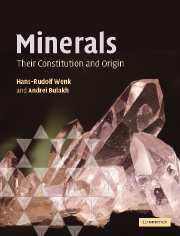Book contents
- Frontmatter
- Contents
- Preface
- Acknowledgments
- Figure credits
- Part I Structural features of minerals
- Part II Physical investigation of minerals
- Part III Variety of minerals and mineral-forming processes
- Part IV A systematic look at mineral groups
- 19 Important information about silica materials and feldspars
- 20 Simple compounds. Unusual mineral occurrences
- 21 Halides. Evaporite deposits
- 22 Carbonates and other minerals with triangular anion groups. Sedimentary origins
- 23 Phosphates, sulfates, and related minerals. Apatite as a biogenic mineral
- 24 Sulfides and related minerals. Hydrothermal processes
- 25 Oxides and hydroxides. Review of ionic crystals
- 26 Orthosilicates and ring silicates. Metamorphic mineral assemblages
- 27 Sheet silicates. Weathering of silicate rocks
- 28 Chain silicates. Discussion of some igneous and metamorphic processes
- 29 Framework silicates. Zeolites and ion exchange properties of minerals
- Part V Applied mineralogy
- Appendices
- Glossary
- References
- Index
- Plate section
- References
22 - Carbonates and other minerals with triangular anion groups. Sedimentary origins
from Part IV - A systematic look at mineral groups
- Frontmatter
- Contents
- Preface
- Acknowledgments
- Figure credits
- Part I Structural features of minerals
- Part II Physical investigation of minerals
- Part III Variety of minerals and mineral-forming processes
- Part IV A systematic look at mineral groups
- 19 Important information about silica materials and feldspars
- 20 Simple compounds. Unusual mineral occurrences
- 21 Halides. Evaporite deposits
- 22 Carbonates and other minerals with triangular anion groups. Sedimentary origins
- 23 Phosphates, sulfates, and related minerals. Apatite as a biogenic mineral
- 24 Sulfides and related minerals. Hydrothermal processes
- 25 Oxides and hydroxides. Review of ionic crystals
- 26 Orthosilicates and ring silicates. Metamorphic mineral assemblages
- 27 Sheet silicates. Weathering of silicate rocks
- 28 Chain silicates. Discussion of some igneous and metamorphic processes
- 29 Framework silicates. Zeolites and ion exchange properties of minerals
- Part V Applied mineralogy
- Appendices
- Glossary
- References
- Index
- Plate section
- References
Summary
Introduction
Carbonates are the primary representative of compounds with an (XO3)n- radical. About 170 different carbonate minerals are known. Most of them are simple salts of carbonic acid (H2CO3), such as calcite (CaCO3) and dolomite (CaMg(CO3)2). Others contain additional anions -for example, malachite (Cu2(CO3)(OH)2) – and a few are mixed chemical compounds (sulfate-carbonates, phosphate-carbonates, arsenate-carbonates, borate-carbonates, nitride-carbonates, silicate-carbonates). We have mentioned two of these, burkeite (Na2CO3(SO4)2) and hanksite (Na2K(SO4)9(CO3)2Cl), in Chapter 21.
Apart from its role in carbonates, the (XO3)n- radical is also present in nitrates and borates. In some borates, the BO33- groups are isolated as in calcite, but in most the planar triangular groups are linked to form chains and sheets. Moreover, there are also borates with BO45- tetrahedra in their crystal structures, or with combinations of BO33- triangles and BO45- tetrahedra.
A list of the important carbonates, nitrates, and simple borates is given in Table 22.1. The most common carbonates, calcite and dolomite, comprise nearly 2.5% of the volume of the earth's crust.
Characteristic features of composition and crystal chemistry of carbonates and borates
By their chemical nature, the carbonate minerals are the most stable salts of carbonic acid. This acid is relatively weak and prefers to bond with elements of low ionization potentials (sodium, potassium, calcium, strontium) that are not too small in size (such as lithium).
- Type
- Chapter
- Information
- MineralsTheir Constitution and Origin, pp. 359 - 375Publisher: Cambridge University PressPrint publication year: 2004



